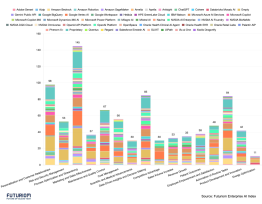AI Chip China Access Tax Has Pros and Cons

In an unusual move, the U.S. Government has agreed to release licenses for NVIDIA and AMD to sell their chips in China in return for a 15% cut of the revenues.
While the decision has been criticized as dangerous to national security by officials in both Washington and Beijing, it has been lauded by the vendors as advancing U.S. interests by encouraging American dominance in the AI chip market while giving stateside developers access to a broad range of international expertise.
At the same time, the move raises questions about whether it will result in the vendors raising prices for the China market to avoid reducing profit margins, something that could potentially alienate Chinese buyers.
Both NVIDIA and AMD were granted permission in July by U.S. President Donald Trump to ship their chips to China, reversing an April decision forbidding sales. But after three weeks of waiting for the licenses to be officially released, NVIDIA CEO Jensen Huang met with Trump last week to request action. The revenue-sharing deal apparently surfaced from that negotiation.
NVIDIA will be authorized to sell the H20, a chip modified for sale to the PRC market, and AMD will ship its own specially designed MI308 chip. While it’s not clear how much the government stands to gain on the sales, or what it will do with the money, NVIDIA in June said it was missing out on a $50 billion opportunity to sell its chips in China. Further, there's the question of future U.S. ability to influence the AI market. “Fifty percent of the world’s AI researchers are Chinese,” NVIDIA CEO Huang said. “This is an industry [in which] we will have to compete.”
The Pros and Cons of Selling AI Chips to China
This development is controversial on several fronts. Officials in the U.S. say the H20’s inferencing capabilities put it ahead of NVIDIA’s older H100 chips. This means the H20 could spur innovations in China’s military technologies, particularly given that nothing happens in the PRC that isn’t under government control.
The argument works on the other side, too: Beijing officials recently weighed in online with claims that the H20 in particular could be a Trojan horse for American intelligence, allowing for “remote shutdown” of processes. These claims are vehemently denied by NVIDIA.
Apparently, Trump doesn’t see the problem, as long as he’s making money from the deal while furthering his efforts to arrange trade negotiations with Chinese President Xi Jinping. Part of that effort also manifests in the U.S. Government’s choice to freeze controls on exports to China (more on that momentarily). At the same time, though, the 15% cut must come from somewhere, and the potential cost to Chinese buyers could represent a barrier to trade talks.
NVIDIA’s Jensen Huang has argued that the U.S. will cede the AI market if it’s restricted in China. During a conversation at the Milken Institute think tank on May 13 he said:
“NVIDIA, of course, is the world leader today, but in our absence, if we don't serve a particular market, if we leave a market altogether, there's no question, somebody else would step in. Huawei, for example, is very formidable, one of the most formidable technology companies in the world.”
NVIDIA sent us the following statement from a company spokesperson:
"We follow rules the U.S. government sets for our participation in worldwide markets. While we haven't shipped H20 to China for months, we hope export control rules will let America compete in China and worldwide. America cannot repeat 5G and lose telecommunication leadership. America’s AI tech stack can be the world’s standard if we race."
More Chip Deals to Come?
The latest salvo in U.S.-China chip relations is part of a larger context. Beijing wants the U.S. to lift restrictions on high-bandwidth memory (HBM) chips, which are needed for use in producing AI components—such as those being created by Huawei. At the same time, Donald Trump regularly uses economic force to bend American companies to his will when it comes to investing in the U.S. That said, as noted it’s not clear where the 15% chip revenue will actually come from, or where it will land.
It all adds up to a situation that calls for a delicate balancing act between the superpowers, one requiring a realistic assessment of the influence of AI on the military of both countries while keeping an eye on the advantages of ongoing U.S. market dominance and U.S.-China developer cross-pollination. It will also be important to weigh the potential impact of the 15% cut on the companies involved, and the possible outcome if the cut results in higher prices.
Futuriom Take: Washington’s plan to allow NVIDIA and AMD to sell their chips in the PRC is shadowed by doubts about the wisdom of the move, along with arguments about its benefits. The outcome depends on complex negotiations between opposing superpowers—something that may not be achievable.



















